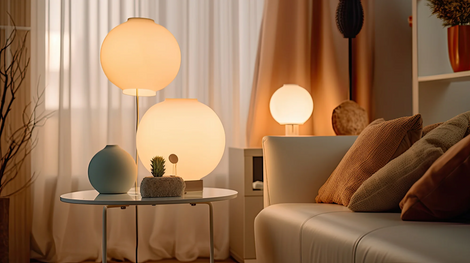Lighting is one of the most important, but often underestimated, elements of interior design. It has a significant impact not only on how a space looks, but also on how we feel in it, relax, work or communicate. Nevertheless, when planning a home interior, lighting is often given too little attention – or it is chosen hastily, only based on aesthetics, forgetting about function. The result? Lack of comfort, inconvenience in everyday life and poor light balance. Here are 5 common mistakes that many people make – and practical tips on how to avoid them.
1. One light source for the entire room
A ceiling light alone is like trying to illuminate a stage with a single bulb. The light becomes flat, the shadows are frighteningly deep, and important spaces (like a reading nook or kitchen countertop) remain unlit. This scheme doesn’t work in the living room, kitchen, or bedroom.
How to avoid?
Plan your lighting in layers:
– General lighting – ceiling light or recessed lights
– Task lighting – table or pendant lights in certain areas
– Decorative lighting – LED strips, floor lamps, niche accents
This approach allows you to not only achieve the required amount of light, but also change the atmosphere depending on the time of day or mood.

2. Inappropriate lighting mood in different spaces
Not every light is suitable for every space. Too white, cold light can make you feel uncomfortable, reminiscent of a hospital or office, and too yellow can strain your eyes in places where you need to concentrate. One of the most common mistakes is using the same light bulb in the bedroom, kitchen, and bathroom. The result? The light doesn't work as it should in any space.
How to avoid?
Think about the function each room should fulfill. In the living room or bedroom, the light should be warm, cozy, and set a pleasant mood for the evening. In the kitchen, it should be clear, sufficient, but not dazzling, so that it is comfortable to cook. In the bathroom or work area, it should be bright, but not too harsh, to help you concentrate and see the mirror or screen clearly. If in doubt, choose adjustable lamps or bulbs that allow you to change the tone of the light - this will allow you to adapt each zone to your mood or time of day.

3. Lighting planning is left to the last minute
This is what leads to improperly routed sockets, strange wiring directions, and lights hanging in the wrong places. Then you have to find compromises or accept an inconvenient layout.
How to avoid?
Plan your lighting in parallel with your furniture arrangement. Ask yourself these questions:
– Where will I sit when I read?
– Where do I get ready in the morning?
– Where would I like to create an atmospheric background?
Based on these answers, plan the locations of switches, types of lights, and heights. Such a plan will not only help you avoid running wires through the middle of the wall, but will also improve your daily comfort.
4. Incorrect height and proportions of the lamps
A pendant lamp above a table that hangs too low and obstructs the view, or a small lamp in a high room that "drowns" in the space - these are not only aesthetic but also functional problems.
How to avoid?
Follow these guidelines:
– Above the dining table – 70–85 cm from the surface
– Wall lights – 150–160 cm from the floor
– Table lamps – a light source at eye level when sitting
Also consider the diameter of the lamp. For example, an 80 cm wide lamp will not fit over a small dining table - it will obscure the entire view. The proportions should match both the furniture and the size of the room.
5. Too much focus on design, too little on function
Design trends tempt us to buy impressive, but often impractical, lighting fixtures. For example, a glass ball-shaped fixture without a light diffuser can be dazzling, while a metal shade with a narrow opening won't even illuminate half of a table.
How to avoid?
Determine the main function of the lamp: is it intended to illuminate or create a mood? If light is needed for work, reading or makeup, choose models with a directional and even light flow. Design is important, but only if the light distribution is effective.

Mistakes that are often not even thought about
-
Too much "cold" light in modern interiors - it is especially popular to use 6000K LED strips, which can create a feeling of sterility.
-
Too much symmetry – when the lights are placed too evenly, the space loses its liveliness.
-
Lights without switching capabilities – one switch for all lights means zero flexibility.
Ensure that the lighting plan is carried out responsibly
Lighting is not the last detail of the interior, but one of its main components. It affects both aesthetics, function and emotion. Every mistake can cost not only money, but also the quality of everyday life. Therefore, it is worth investing time in a thoughtful decision - or even better, consult with professionals.
If you are looking for lamps that combine style, light quality and practicality – Browse the Maison Home lighting collection . Here you will find all types of lighting solutions - from functional to decorative, from classic to modern minimalism.




